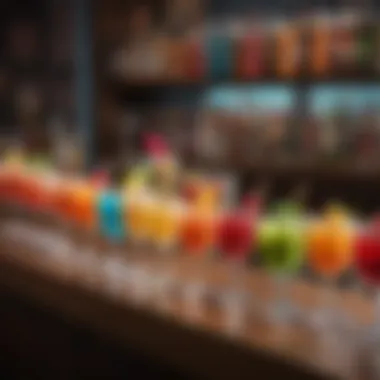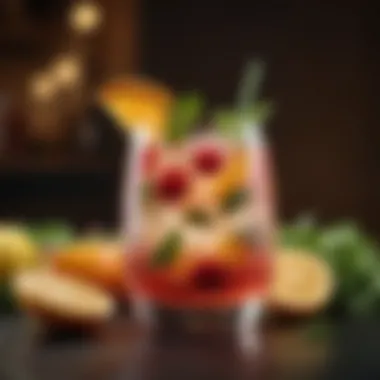Exploring the World of Sweet Drinks at Bars


Intro
Sweet drinks have carved their own niche in the spectrum of beverages served at bars. Their appeal sometimes people cannot resist is strong, given the well-crafted balance of flavor and enjoyment they provide. From fruity cocktails like the Piña Colada to unique creations that challenge the senses, the diversity is vast.
This exploration is not just about flavor; it is about context. Sweet drinks often play an integral role in unsated social gathering, celebrating occasions, or simply making an evening more enjoyable. Each pour reflects someone's preference and tells stories about culture and tradition.
In keeping with this, this guide wants to illuminate ingredient choices, preparation methods, and the essence of what makes sweet drinks both enjoyable and significant in today's world. Understanding these elements can enable consumers to appreciate their drinks more fully. It is equally important to recognize the relevance of mindful consumption amidst indulging in sweetness—and this article will touch on that.
Armed with practical knowledge, readers will discover the often complicated relationship between sweet drinks and our society while getting to grips with recipes and techniques to enhance their experience.
Next, we explore a specific sweet drink recipe that highlights these themes and practices.
Recipe Highlight
Let’s center our attention on a cocktail known for its tropical vibrancy—Coconut Mojito. This drink creates a refreshing yet inviting notion that can set the tone for an entire evening.
Essential Ingredients
- Fresh mint leaves
- White rum
- Coconut cream
- Fresh lime juice
- Sugar (or simple syrup)
- Club soda
- Crushed ice
Estimated Preparation Time
- Approximately 10 minutes
Servings
- Yields 2 servings
Now we turn our attention to the intricacies involved in making this delightful coconut mojito.
Step-by-Step Instructions
- In your glass, muddle a handful of fresh mint leaves with one tablespoon of sugar. A gentle touch is best, just enough to release the mint oils.
- Add the lime juice and rum to the glass. Mixing these smoothly is crucial as it sets the framework for the existing flavors.
- Next, include the coconut cream, which is the magic ingredient. Stir well to integrate this into the lime and rum.
- Pack the glass with crushed ice, which adds some chill to the combination.
- Finally, pour club soda to fill the glass, and garnish with a few mint sprigs for decoration.
Remember, avoiding over-muddling is a common mistake—keeping the mint leaves intact is vital for flavor retention.
Variations and Substitutions
There are so many creative substitutions to explore here. You can replace the white rum with aged rum for a deeper flavor profile or use coconut water instead of coconut cream for a lighter option.
For an added twist, consider incorporating slices of fresh pineapple or infusing your social event style by serving with flavored syrups. Pairing this cocktail with light appetizers such as shrimp cocktails or mango salsa works delightfully together.
Time-Saving Cooking Tips
To enhance the efficiency of prep work:
- Pre-chop fresh mint and store in a sealable bag in the fridge!
- Mix portions of the sugar with lime juice and rum in advance for several servings.
Investing in a muddler can make muddling both quicker and cleaner, saving time and effort.
Preparation does not have to be tiring. Pre-mixturing can streamline the multiple rounds of cocktail making.
Nutritional Information
- Approximately 200 calories per serving
- Each serving contains vitamin C from fresh lime and a small source of iron from mint
- Suitable for gluten-free diets
This recipe stands not only as a delightful treat but as a glimpse into the wider community of sweet cocktails at bars. Juggling between craft and simplicity defines this refreshing cocktail—a projection of how deliberately enjoyed beverages influence modern social circumstances gracefully.
In appreciating sweet drinks, one delves into a reflection of tastes and traditions which connect us in varying cultural guises.


Preamble to Sweet Drinks
Sweet drinks occupy a notable space within bar menus and social settings. They appeal to a broad audience and can enhance the drinking experience significantly. Understanding what sweet drinks represent can deepen appreciation for the choices available at a bar. This segment sets the stage for exploring various aspects of sweet beverages and why they have gained popularity.
Defining Sweet Drinks
Sweet drinks can be described as cocktails and beverages that have a noticeable sugary flavor. These drinks often include assorted ingredients like fruits, syrups, or liqueurs. Typically, their taste varies from mildly sweet to intensely sugary, depending on the blend of components used. Moreover, there exists vast diversity within this category, ranging from sweet margaritas to dessert cocktails.
The sweetness is derived from various sources, such as:
- Fresh fruits like cherries and oranges.
- syrups, including simple syrup and flavored varieties.
- Liqueurs, e.g., Amaretto, and Pimm’s, which add sweetness and flavor complexity.
It is important to note that the definition of sweet drinks is not static. As creativity evolves among mixologists and consumers alike, the realm of sweet beverages continues expanding.
The Social Context of Sweet Drinks
Sweet drinks usually carry a social significance that transcends mere taste. They play a role in celebrations, gatherings, and shared experiences. Bars often use these appealing beverages to create a welcoming atmosphere. People are drawn to the bright colors, enticing aromas, and flavors that sweet drinks provide.
Studies show that drinks that taste sweet can enhance the enjoyment and satisfaction of social occasions. These drinks often bridge conversational gaps and foster interactions among patrons. Their presence can lift moods and elevate celebrations. Understanding this social backdrop emphasizes the role sweet drinks play in modern drinking culture. People often reach for sweet drinks during special events or casual outings with friends, underscoring their importance in social contexts.
“Sweet drinks engage taste buds and create memorable experiences that last beyond the evening.”
In summary, knowing the foundational aspects of sweet drinks—what they are and their place in social environments—offers valuable insights for those interested in bars and cocktails.
The Origins of Sweet Drinks
Understanding the origins of sweet drinks is essential in comprehending their evolution and current popularity. These beverages have morphed throughout centuries, shaped by various historical events, societal behaviors, and cultural preferences. This richer context helps explain why sweet drinks have a peculiar hold on many people and how they can escalate a social encounter.
Historical Background
Sweet drinks have a long and diverse history. They can be traced back to ancient civilizations. For example, China and Egypt were some of the earliest regions known to incorporate fruits into alcoholic beverages. Sweetness, at that time, was often associated with nobility and indulgence, making sweet drinks a symbol of prestige.
In medieval Europe, the addition of spices and sweet fruits rather enhanced drinks. In this period, honey or sugar was used to mask the flavors of lower-quality spirits. The major turning point came during the Age of Exploration, when sugar cane was introduced from the New World. This made sweetness more accessible and led to the creation of many sweet drink recipes.
Today, beverages like cocktails and craft mixers dominate bars everywhere. Historic drinks may often already target sweetness. This historical backdrop reveals why many drinks today rely on sweetness not just for taste, but also for tradition.
Cultural Influences on Sweet Beverage Choices
Cultural differences greatly influence the type of sweet drinks favored in various contexts. Regional ingredients often shape local variations. For instance, tropical areas tend to favor fruity flavors, while colder regions may prefer spiced or creamy options.
In addition, social contexts play a notable role when selecting sweet beverages. For example, in the United States, summer barbecues often feature sweet concoctions like piña coladas. Restaurants might offer sweeter drinks with colorful presentation to invoke a festive atmosphere.
Globally, popular social trends also inject new life into sweet drink recipes.** With growing interest in health-conscious options, some cultures now prefer sweet drinks that use natural juices and alternative sweeteners like agave syrup.
In essence, the origins and cultural influences intertwine, providing depth to our understanding of sweet drinks today. They reflect tastes shaped not only by history but also by social practices and emerging trends.
Common Ingredients in Sweet Drinks
Understanding the common ingredients in sweet drinks enhances appreciation for their diverse flavors and appeal. The combination and quality of these ingredients not only define the tastes people crave but also shape the drinking experience. From consumers looking for exciting flavors to craftsmen mastering mixology, these components are central to creating delightful beverages.
Fruits and Juices
Fruits and juices are essential elements in many sweet drinks. They offer natural sweetness and a refreshing quality that complements other ingredients. Typically, vibrant fruits like pineapples, strawberries, and citrus fruits such as lemons and limes play major roles. Their juices serve as bases or accents in cocktails.
There is an additional benefit. The use of fruits and their juices adds nutrition, including vitamins. However, factors such as sourcing ripe fruits or avoiding overly processed juices must be considered. The expectation is for freshness and flavor complexity, thus elevating the overall experience.
Fruits not only sweeten drinks but also inject brightness into the flavors.
Syrups and Liqueurs


Syrups and liqueurs bring an added layer of sweetness while also introducing unique flavors. For example, simple syrup forms an essential base for numerous cocktails, combining equal parts sugar and water. Hibiscus syrup, agave syrup, and many fruit-flavored syrups add not just flavor but also a visual appeal with vibrant colors.
Liqueurs such as Triple Sec, Amaretto, and Peach Schnapps serve dual purposes. Firstly, they sweeten drinks while enriching them with their distinctive flavor profiles. Crafting an informative drink requires careful balancing. Too much sweetness from these ingredients can overwhelm other flavors, disrupting the cocktail's intended equilibrium.
Mixers and Alcohol Base
Mixers and the alcohol base underpin sweet drink recipes in significant ways. Soda, tonics, and ginger ale usually lighten drinks while adding texture. The choice of mixer must enhance the drink without overshadowing it. Selecting appropriate mixers can transform a drink, drawing out notes from the primary ingredients as well as maintaining sweet appeal.
Moreover, the alcohol base, which could be vodka, rum, or gin, shapes the fundamental nature of the drink. Each alcohol has unique characteristics and alters how sweetness is perceived. For instance, vodka tends to act as a blank canvas, while drinks featuring spiced rum may veer toward a full-bodied flavor. Thus, one must concentrate on harmonious initiatives between base spirit and additions, promoting a balanced and adaptable drinking flow.
Popular Sweet Drinks at Bars
Sweet drinks hold a prominent place in the bar scene. They cater to a wide range of tastes, drawing in patrons who might seek comfort in familiar flavors or adventure in new experiences. Understanding popular sweet drinks is essential to appreciating the atmosphere of a bar and the social connections forged within it.
Signature Cocktails
Signature cocktails are custom creations by mixologists that embody the unique identity of a bar. They often boast creative names and interesting ingredients. The incorporation of fresh fruits, distinctive liqueurs, and imaginative garnishes helps to create an unforgettable taste experience. Popular examples include the beloved Pina Colada, which blends rum, coconut cream, and pineapple juice, and Mojitos, known for their refreshing combination of mint, lime and soda.
The popularity of signature cocktails extends beyond simple taste. They become symbols of the location, carrying a sense of belonging among regular patrons. A skillfully crafted signature cocktail often serves as an impressive statement of a mixologist’s artistry.
Classic Sweet Cocktails
Classic sweet cocktails are the time-honored favorites that remain relevant. They have withstood the test of time due to their universal appeal and ease of preparation. Drinks like the Daiquiri, made with rum, lime juice, and sugar, and the Cosmopolitan, which marries vodka, triple sec, cranberry juice, and lime juice, embody qualities that many people find pleasing.
Learning about these classics presents an opportunity for bars to pay homage to tradition while potentially modernizing the recipes. The balance of flavors in these drinks is crucial, illustrating how sweetness can blend harmoniously with other taste elements like acidity and bitterness.
Unquestionably, these cocktails serve as a gateway for an audience new to cocktails, education on what flavors to expect when exploring their taste preferences.
Seasonal and Themed Drinks
As seasons change, so does the bar menu. Seasonal and themed drinks utilize ingredients that tie closely with specific times of the year. For instance, during summer, a Watermelon Margarita made with fresh watermelon puree can provide a refreshing respite from the heat. In the colder months, a Spiked Apple Cider, blending warm apple cider with spiced rum, brings comfort and nostalgia.
Moreover, special occasions lead spirits makers to produce themed cocktails that coincide with cultural events or holidays. Games like the Super Bowl often inspire sports-themed drinks. Navigating through these variations highlights the bar environment as one that adapts and transforms based on social gatherings and lifestyle patterns.
Recognizing these popular sweet drinks can deepen the understanding of how social occasions are enriched through carefully crafted beverages.
In summary, familiarizing oneself with the nuances of these sweet drinks illustrates the underlying charm of cocktails in social settings. They invite exploration, offering enticing ways to connect and celebrate shared experiences.
Crafting Sweet Drinks: Techniques and Tips
Crafting sweet drinks requires a blend of art and science. The quality of these beverages often depends on the understanding of fundamental mixology techniques. It also necessitates adequate knowledge about the structure and flavors of the ingredients used. Not only does skillful mixology elevate the drinking experience, but it also brings clarity to personal preferences. Whether one's interest lies in creating a delicate cocktail or a robust sweet drink, proper techniques can greatly enhance the overall outcome. It emphasizes creativity while also honoring historical contexts and preferences.
Mixology Basics
Mixology is the foundation of any successful bar experience, particularly with sweet drinks. Understanding core techniques such as shaking, stirring, and muddling is crucial. Each method is suited for different types of drinks. For instance, shaking ensures a diluted and chilled outcome, essential for fruit-heavy shakes like a sweet daiquiri.
On the contrary, stirring is a softer process that integrates flavors without over-dilution. This technique works well for spirit-focused drinks, creating a lovely texture without losing sweetness too quickly. Muddling involves releasing the natural oils and juices from herbs and fruits, which play an essential role in creating vibrant flavors.
Common tools include shakers, strainers, and bar spoons. Familiarity with these tools assists in maintaining consistency and efficiency. Each sweet drink should reflect a balance of flavor, temperature, and presentation for its optimal appreciation.
Garnishes and Presentation
Presentation is not merely an aesthetic practice but an essential part of the drinking experience. The right garnishes enhance sweetness, complementing the flavors in the drink. Common garnishes include fruits, herbs, and even specialty syrup drizzle.
Using lemon or lime twists can brighten a sweeter drink’s overall flavor profile. Barry not switch ups can even involve applying sugared rims on glasses to contribute additional sweetness right at the edge.
Interesting glassware makes a noticeable contribution to the experience as well. The choice between a highball, martini, or coupe glass transforms the visual impact of the drink. Each design serves enhance the purpose and ambiance of the drink being served. As much as taste matters, sight plays a vital role in cocktail enjoyment and appreciation.
Balancing Flavors with Sweetness


Finding balance in sweet drinks remains an essential skill. While sweetness is gratifying, overly sweet cocktails can diminish the overall flavor profile. Learning how to incorporate acidity and bitterness is vital. Citrus juices, such as lemon or orange, can pivot the experience from being sickly sweet to refreshing.
Moreover, integrating bitter components, such as bitters or even some spirit types, helps in creating depth and complexity of flavor. Good sweet drinks achieve equilibrium by gradually building complexity rather than relying solely on sugar. This brings harmony to the experience.
The Role of Sweet Drinks in Modern Drinking Culture
Sweet drinks have carved a unique niche in modern drinking culture, serving not only to delight the palate but also to actuate significant social dynamics. The affectionate embrace of sugar-rich liquors presents both challenges and communal aspects. As personal tastes have evolved, these beverages have become more than mere refreshers; they have turned into emblematic choices that reflect individual identity and societal trends.
Social Interactions and Sweet Drinks
Sweet drinks play a pivotal role in social interactions at bars. They are often seen as a choice associated with celebration and joyous occasions. The sweetness in these beverages is not only appealing in flavor but facilitates emotional bonding. A cocktail like the Piña Colada or the Strawberry Daiquiri becomes a conversational starter, a blend of flavors triggering warmth and rapport among customers. When ordering these drinks, patrons engage in discussions about preferences, share tastes, and exchange recommendations. The fun and visually appealing nature of many sweet drinks further fosters an engaging environment, where patrons find common ground amidst a distinct cultural setting.
Another layer of social engagement is how these drinks might influence atmosphere. In bars that favor sweet cocktails, the ambiance can shift towards a more relaxed and light-hearted tune, encouraging laughter and interaction. As conversations unfold with the aid of these beverages, they provide an elixir of unity among diverse patrons, each enjoying their unique range of flavors—be it through discussing exotic liqueurs or sharing experiences around popular cocktails.
Trends and Innovations
Trends in sweet drinks are constantly shifting, influenced by various factors ranging from cultural exchanges to technological advancements. Recent years have seen a significant uptick in innovative approaches towards traditional sweet beverages. Contemporary mixologists continually experiment with ingredients, crafting visually arresting and flavor-forward cocktails that test the limits of classic paradigms.
For instance, there is a growing emphasis on using natural ingredients and artisan syrups. Craft producers are now delving into crafting small-batch products to meet health-conscious consumers who crave authenticity over mass-produced sweetness. Flavored syrup selections like those from Monin or Torani evoke character while aligning with modern preferences for less refined sugars. The intersection of sweet drinks with local sourcing and sustainability reflects a broader cultural trend where conscious consumerism shines.
Social media generates much attention and engagement around sweet drinks. Bars adeptly leverage platforms like Instagram and Facebook to showcase their concoctions, sparking interest and excitement among potential visitors. Signature and seasonal menus also take on a transformative perspective, turning drinks into artistic statements rather than simple refreshments. This trend frequently leads patrons to seek out unique variations that can be shared online, creating a tight bond between drinks, community, and digital storytelling.
In summary, sweet drinks exemplify a rich cultural significance, harmonizing flavors with social interactions while adapting to ongoing trends. They enrich the bar experience and represent changing consumer preferences, ensuring their presence remains relevant in the ever-evolving landscape of beverage consumption.
Mindful Consumption of Sweet Drinks
Drinking sweet beverages often blends accessibility with indulgence, making them popular choices at bars. However, mindful consumption is an increasingly important topic within this context. Awareness about what goes into your sweet drink can significantly impact health and overall enjoyment.
The significance of mindfulness in this matter extends beyond mere pleasure. Consume responsibly; it's the intersection between enjoyment and health. Being mindful promotes understanding of various effects, such as taste alterations and sugar’s physiological impacts on the body. Consideration of these factors can reshape our relationship to drinks perceived as simple treats.
Understanding Sugar Content
Awareness of sugar content is crucial. Excessive sugar intake can lead to adverse health outcomes, including obesity and heart disease, as discussed in multiple health studies. Knowledge about how much sugar is within your chosen drink allows for informed decisions in social scenarios. Common sweet drinks, such as a Piña Colada or Sweet Tea Vodka, range significantly in sugar.
Using measuring examples:
- Margarita: Has an average sugar content between 22 - 25 grams.
- Cosmopolitan: Contains about 10 - 12 grams.
- Mai Tai: Can surpass 30 grams easily.
While enjoying these flavors, miniszinh understanding total daily sugar limits is wise. Additionally, mentors often suggest drinking water in between cocktails. This practice not only helps with moderation but also aids digestion.
Alternatives to Traditional Sweet Drinks
Exploring alternatives offers various benefits. Switching tall drinks rich in sugar content might help with managing caloric intake. Options such as low-calorie sweeteners or naturally sweet alternatives like stevia represent ways to keep sweetness without overloading on sugar.
Some noteworthy alternative beverages include:
- Sparkling Water with Fresh Fruits: Provides both carbonation and flavor, minus substantial calories.
- Herbal Infusions: By combining fruits or sweet herbs, flavorful, non-sugar options manifest nicely.
- Low-Sugar Cocktails: Options like the Vodka Soda allow for taste while minimizing sugar excess.
In summary, paying attention to sugar in sweet drinks can encompass mindful practices that amplify enjoyment without jeopardizing health. The goal is to embrace alternatives that satisfy unique tastes, ensuring you remain both centered and fulfilled during a night out or within the comfort of home.
The End
The exploration of sweet drinks at bars is essential to understand their significant role in contemporary drinking culture. Sweet drinks not only provide a pleasing flavor profile but also encourage socialization and create memorable experiences. Their versatility caters to a wide variety of palates, which makes them a staple in many drinking environments.
The Impact of Sweet Drinks on the Bar Experience
Sweet drinks profoundly affect how patrons engage with bars. They serve as conversation starters, often igniting connections between individuals who share a taste for fruity or sugary beverages. Additionally, they allow bars to showcase their creativity. Bartenders can experiment with unique recipes, incorporating seasonal fruits, unique syrups, and artisanal mixers. This, in turn, can attract a more extensive clientele who come for specific sweet beverages.
Moreover, the tangible satisfaction derived from sweet drinks enhances the bar atmosphere. For many, these drinks act as a form of self-indulgence, creating a relaxed environment where customers can enjoy decompress after a hectic day.
Future of Sweet Drinks in the Beverage Industry
Looking ahead, the landscape of sweet drinks is poised for transformation influenced by emerging trends driven by health-awareness. There is a growing consumer preference towards low-sugar or no-sugar alternatives. The age of health consciousness encourages bartenders to innovate beyond traditional recipes. The introduction of sweet drinks that yoga new ingredients like agave nectar, local honey, or natural fruit extracts could becoming increasingly popular.
Additionally, blending alcoholic with non-alcoholic components is gaining traction. Mocktail options that mirror the taste experience of sweet cocktails pave the way for more inclusive bar menus. This evolution toward a more mindful drinking culture suggests that the sweet drink category will expand and diversify further.







